Tesco Plc Financial Analysis Report: Company Valuation and Capital
VerifiedAdded on 2023/01/06
|14
|2630
|3
Report
AI Summary
This finance report provides a comprehensive analysis of Tesco Plc, a major British retailer. It begins with a comparative financial analysis using ratio analysis, comparing Tesco to its competitors, Morrisons and J Sainsbury. The analysis covers liquidity, solvency, profitability, efficiency, and market prospect ratios, providing insights into each company's financial health. The report then delves into company valuation, employing asset-based valuation, dividend valuation model, and price-earnings (P/E) ratio methods to determine Tesco's value. Finally, the report addresses capital structure, calculating the cost of debt, cost of equity, and weighted average cost of capital (WACC) for Absolute Plc, including a discussion of the limitations of WACC calculations. The report concludes by summarizing the key findings and emphasizing the broad scope and significance of finance in business operations.

Finance
1
1
Paraphrase This Document
Need a fresh take? Get an instant paraphrase of this document with our AI Paraphraser
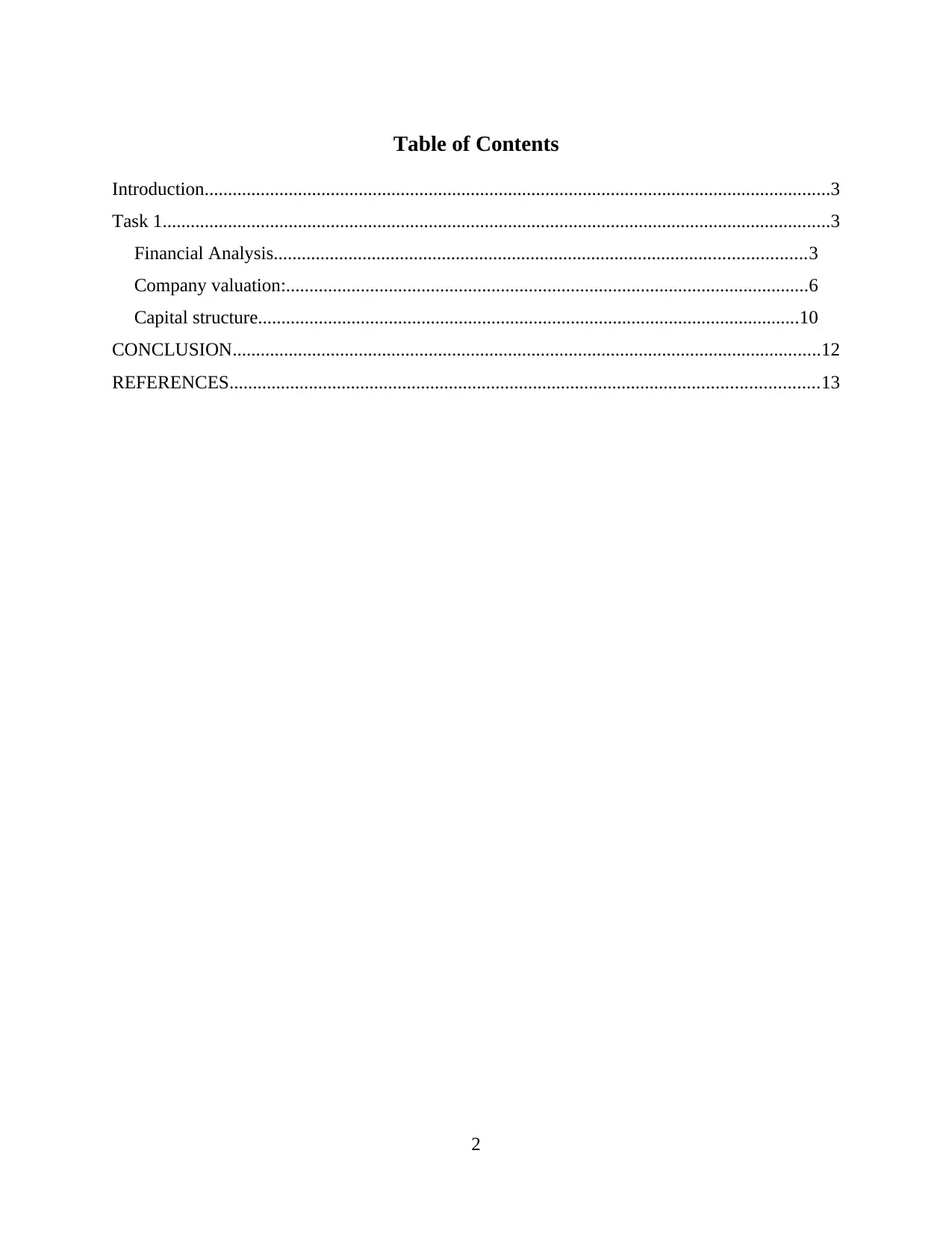
Table of Contents
Introduction......................................................................................................................................3
Task 1...............................................................................................................................................3
Financial Analysis..................................................................................................................3
Company valuation:................................................................................................................6
Capital structure....................................................................................................................10
CONCLUSION..............................................................................................................................12
REFERENCES..............................................................................................................................13
2
Introduction......................................................................................................................................3
Task 1...............................................................................................................................................3
Financial Analysis..................................................................................................................3
Company valuation:................................................................................................................6
Capital structure....................................................................................................................10
CONCLUSION..............................................................................................................................12
REFERENCES..............................................................................................................................13
2

Introduction
Finance is a broad term used for management of money and investment activities related
to money. It represents process of raising funds for the business operations and their
management (Choi and et.al., 2018). It deals with activities associated with leveraging, debt-
equity, capital market, etc.
Tesco Plc is a British company founded in 1919. It operates as a groceries and general
merchandise retail chain. The stores also provide software and financial services. It offers both
online and offline channels of distribution. The following report contains three major parts. First
part contains assessment of financial and operating performance of Tesco Plc and its two
competitors Morrisons Supermarket Plc and J Sainsbury Plc using comparative ratio analysis.
Second part contains valuation of Tesco through different approaches. Final part consists of
practical questions related to capital structure of Absolute Plc. In it, cost of debt, cost of equity
and weighted average cost of capital is determined.
Task 1
Financial Analysis
Financial analysis refers to the process of using financial information of a company to
assess profitability of businesses, projects or budgets of company. Necessary recommendations
for improvement are made on its basis. Various techniques are used for financial analysis such as
ratio analysis, trend analysis, cash flow and fund flow analysis, etc.
Ratio Analysis - Ratio analysis is a technique of financial analysis which helps
management in gaining insights into company's profitability, liquidity, solvency and efficiency.
It helps management of company in analysing the financial performance and health of company
in comparison to its own historical records as well as competitor's performance (Luo and et.al.,
2016). Financial ratios are grouped in certain categories. Below is the comparative ratio analysis
of Tesco Plc and its two competitors – Morrisons Supermarket Plc and J Sainsbury Plc in above
mentioned categories: Figures are taken from Annual-report of the three companies for period
ending Feb-Mar 2019. Liquidity Ratios – Liquidity refers to a company's capability of converting their assets
into cash. These ratios are fundamental ratios to assess the company's ability to meet its
3
Finance is a broad term used for management of money and investment activities related
to money. It represents process of raising funds for the business operations and their
management (Choi and et.al., 2018). It deals with activities associated with leveraging, debt-
equity, capital market, etc.
Tesco Plc is a British company founded in 1919. It operates as a groceries and general
merchandise retail chain. The stores also provide software and financial services. It offers both
online and offline channels of distribution. The following report contains three major parts. First
part contains assessment of financial and operating performance of Tesco Plc and its two
competitors Morrisons Supermarket Plc and J Sainsbury Plc using comparative ratio analysis.
Second part contains valuation of Tesco through different approaches. Final part consists of
practical questions related to capital structure of Absolute Plc. In it, cost of debt, cost of equity
and weighted average cost of capital is determined.
Task 1
Financial Analysis
Financial analysis refers to the process of using financial information of a company to
assess profitability of businesses, projects or budgets of company. Necessary recommendations
for improvement are made on its basis. Various techniques are used for financial analysis such as
ratio analysis, trend analysis, cash flow and fund flow analysis, etc.
Ratio Analysis - Ratio analysis is a technique of financial analysis which helps
management in gaining insights into company's profitability, liquidity, solvency and efficiency.
It helps management of company in analysing the financial performance and health of company
in comparison to its own historical records as well as competitor's performance (Luo and et.al.,
2016). Financial ratios are grouped in certain categories. Below is the comparative ratio analysis
of Tesco Plc and its two competitors – Morrisons Supermarket Plc and J Sainsbury Plc in above
mentioned categories: Figures are taken from Annual-report of the three companies for period
ending Feb-Mar 2019. Liquidity Ratios – Liquidity refers to a company's capability of converting their assets
into cash. These ratios are fundamental ratios to assess the company's ability to meet its
3
⊘ This is a preview!⊘
Do you want full access?
Subscribe today to unlock all pages.

Trusted by 1+ million students worldwide

short term debt liabilities as and when they become due. Some liquidity ratios are current
ratio, quick ratio, acid-test ratio, etc. Current ratio of companies is determined below:
Current Ratio – It helps managers assess ability of current assets of company to finance
their current liabilities. Ideal ratio is maintained at 2:1 i.e. current assets shall be twice of
current liabilities. Sainsburry has the best current ratio out of the three companies.
(Year: 2019)
(Amount in GBP
million)
Companies
Tesco Plc Morrisons
Supermarket Plc
J Sainsbury Plc
Current-assets 12570 1343 7581
Current-liabilities 20680 3295 11417
Current Ratio 0.61 0.41 0.66
Solvency Ratios – Solvency ratios are also called financial leverage ratios and assess a
company's financial viability in the long term (Hatefi, 2019). These ratios compare debt
levels of company with its equity, assets and annual earnings to evaluate long term
sustainability of the business. Examples of solvency ratios include: debt-equity ratio,
debt-assets ratio, interest coverage ratio, etc. Debt-equity ratios of companies is
determined below:
Debt-equity ratio- This ratio compares company's total debt to its total equity. It reflects t
he ability of equity shareholding of covering all outstanding debts. A high debt/equity r
atio is associated with high risk. As per the below we can conclude that Tesco Plc has
most debt liabilities over its shareholders equity.
Debt-equity ratio = Total Liabilities/Total Shareholders' Equity
(Year: 2019)
(Amount in GBP million)
Companies
Tesco Plc Morrisons
Supermarket Plc
J Sainsbury Plc
Total Liabilities 34213 5285 15085
Total Shareholders' Equity 14834 4631 8456
4
ratio, quick ratio, acid-test ratio, etc. Current ratio of companies is determined below:
Current Ratio – It helps managers assess ability of current assets of company to finance
their current liabilities. Ideal ratio is maintained at 2:1 i.e. current assets shall be twice of
current liabilities. Sainsburry has the best current ratio out of the three companies.
(Year: 2019)
(Amount in GBP
million)
Companies
Tesco Plc Morrisons
Supermarket Plc
J Sainsbury Plc
Current-assets 12570 1343 7581
Current-liabilities 20680 3295 11417
Current Ratio 0.61 0.41 0.66
Solvency Ratios – Solvency ratios are also called financial leverage ratios and assess a
company's financial viability in the long term (Hatefi, 2019). These ratios compare debt
levels of company with its equity, assets and annual earnings to evaluate long term
sustainability of the business. Examples of solvency ratios include: debt-equity ratio,
debt-assets ratio, interest coverage ratio, etc. Debt-equity ratios of companies is
determined below:
Debt-equity ratio- This ratio compares company's total debt to its total equity. It reflects t
he ability of equity shareholding of covering all outstanding debts. A high debt/equity r
atio is associated with high risk. As per the below we can conclude that Tesco Plc has
most debt liabilities over its shareholders equity.
Debt-equity ratio = Total Liabilities/Total Shareholders' Equity
(Year: 2019)
(Amount in GBP million)
Companies
Tesco Plc Morrisons
Supermarket Plc
J Sainsbury Plc
Total Liabilities 34213 5285 15085
Total Shareholders' Equity 14834 4631 8456
4
Paraphrase This Document
Need a fresh take? Get an instant paraphrase of this document with our AI Paraphraser
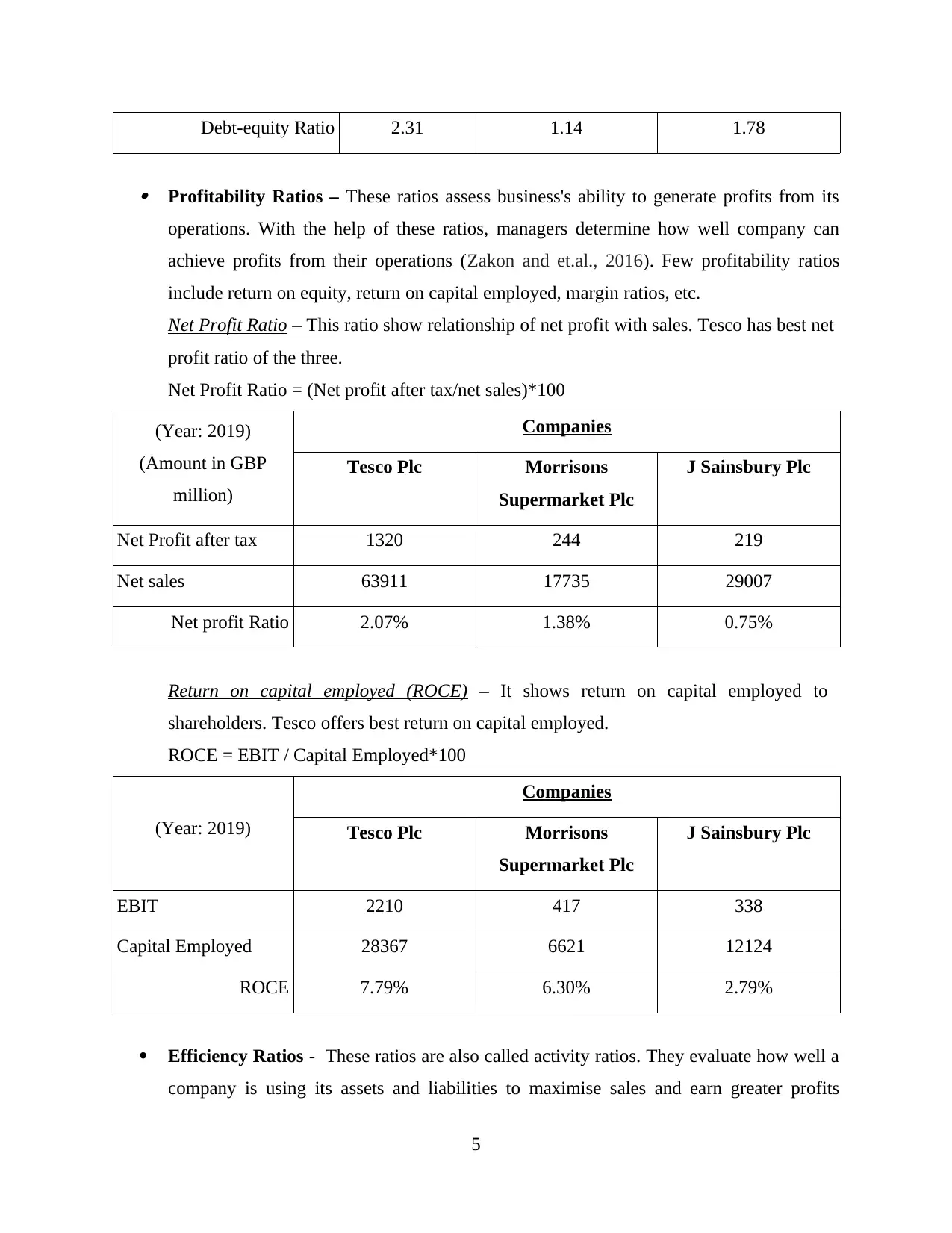
Debt-equity Ratio 2.31 1.14 1.78
Profitability Ratios – These ratios assess business's ability to generate profits from its
operations. With the help of these ratios, managers determine how well company can
achieve profits from their operations (Zakon and et.al., 2016). Few profitability ratios
include return on equity, return on capital employed, margin ratios, etc.
Net Profit Ratio – This ratio show relationship of net profit with sales. Tesco has best net
profit ratio of the three.
Net Profit Ratio = (Net profit after tax/net sales)*100
(Year: 2019)
(Amount in GBP
million)
Companies
Tesco Plc Morrisons
Supermarket Plc
J Sainsbury Plc
Net Profit after tax 1320 244 219
Net sales 63911 17735 29007
Net profit Ratio 2.07% 1.38% 0.75%
Return on capital employed (ROCE) – It shows return on capital employed to
shareholders. Tesco offers best return on capital employed.
ROCE = EBIT / Capital Employed*100
(Year: 2019)
Companies
Tesco Plc Morrisons
Supermarket Plc
J Sainsbury Plc
EBIT 2210 417 338
Capital Employed 28367 6621 12124
ROCE 7.79% 6.30% 2.79%
Efficiency Ratios - These ratios are also called activity ratios. They evaluate how well a
company is using its assets and liabilities to maximise sales and earn greater profits
5
Profitability Ratios – These ratios assess business's ability to generate profits from its
operations. With the help of these ratios, managers determine how well company can
achieve profits from their operations (Zakon and et.al., 2016). Few profitability ratios
include return on equity, return on capital employed, margin ratios, etc.
Net Profit Ratio – This ratio show relationship of net profit with sales. Tesco has best net
profit ratio of the three.
Net Profit Ratio = (Net profit after tax/net sales)*100
(Year: 2019)
(Amount in GBP
million)
Companies
Tesco Plc Morrisons
Supermarket Plc
J Sainsbury Plc
Net Profit after tax 1320 244 219
Net sales 63911 17735 29007
Net profit Ratio 2.07% 1.38% 0.75%
Return on capital employed (ROCE) – It shows return on capital employed to
shareholders. Tesco offers best return on capital employed.
ROCE = EBIT / Capital Employed*100
(Year: 2019)
Companies
Tesco Plc Morrisons
Supermarket Plc
J Sainsbury Plc
EBIT 2210 417 338
Capital Employed 28367 6621 12124
ROCE 7.79% 6.30% 2.79%
Efficiency Ratios - These ratios are also called activity ratios. They evaluate how well a
company is using its assets and liabilities to maximise sales and earn greater profits
5
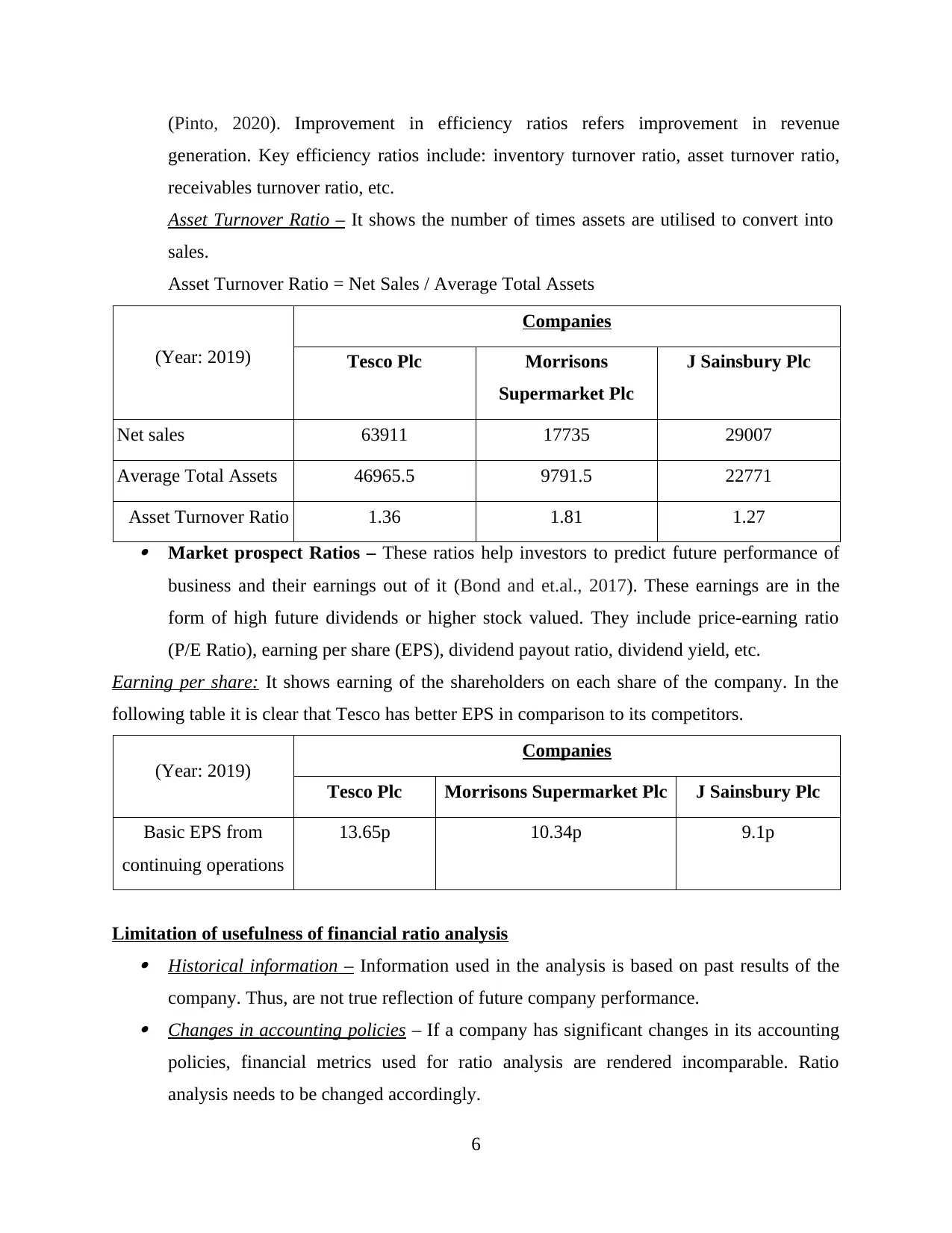
(Pinto, 2020). Improvement in efficiency ratios refers improvement in revenue
generation. Key efficiency ratios include: inventory turnover ratio, asset turnover ratio,
receivables turnover ratio, etc.
Asset Turnover Ratio – It shows the number of times assets are utilised to convert into
sales.
Asset Turnover Ratio = Net Sales / Average Total Assets
(Year: 2019)
Companies
Tesco Plc Morrisons
Supermarket Plc
J Sainsbury Plc
Net sales 63911 17735 29007
Average Total Assets 46965.5 9791.5 22771
Asset Turnover Ratio 1.36 1.81 1.27 Market prospect Ratios – These ratios help investors to predict future performance of
business and their earnings out of it (Bond and et.al., 2017). These earnings are in the
form of high future dividends or higher stock valued. They include price-earning ratio
(P/E Ratio), earning per share (EPS), dividend payout ratio, dividend yield, etc.
Earning per share: It shows earning of the shareholders on each share of the company. In the
following table it is clear that Tesco has better EPS in comparison to its competitors.
(Year: 2019)
Companies
Tesco Plc Morrisons Supermarket Plc J Sainsbury Plc
Basic EPS from
continuing operations
13.65p 10.34p 9.1p
Limitation of usefulness of financial ratio analysis Historical information – Information used in the analysis is based on past results of the
company. Thus, are not true reflection of future company performance. Changes in accounting policies – If a company has significant changes in its accounting
policies, financial metrics used for ratio analysis are rendered incomparable. Ratio
analysis needs to be changed accordingly.
6
generation. Key efficiency ratios include: inventory turnover ratio, asset turnover ratio,
receivables turnover ratio, etc.
Asset Turnover Ratio – It shows the number of times assets are utilised to convert into
sales.
Asset Turnover Ratio = Net Sales / Average Total Assets
(Year: 2019)
Companies
Tesco Plc Morrisons
Supermarket Plc
J Sainsbury Plc
Net sales 63911 17735 29007
Average Total Assets 46965.5 9791.5 22771
Asset Turnover Ratio 1.36 1.81 1.27 Market prospect Ratios – These ratios help investors to predict future performance of
business and their earnings out of it (Bond and et.al., 2017). These earnings are in the
form of high future dividends or higher stock valued. They include price-earning ratio
(P/E Ratio), earning per share (EPS), dividend payout ratio, dividend yield, etc.
Earning per share: It shows earning of the shareholders on each share of the company. In the
following table it is clear that Tesco has better EPS in comparison to its competitors.
(Year: 2019)
Companies
Tesco Plc Morrisons Supermarket Plc J Sainsbury Plc
Basic EPS from
continuing operations
13.65p 10.34p 9.1p
Limitation of usefulness of financial ratio analysis Historical information – Information used in the analysis is based on past results of the
company. Thus, are not true reflection of future company performance. Changes in accounting policies – If a company has significant changes in its accounting
policies, financial metrics used for ratio analysis are rendered incomparable. Ratio
analysis needs to be changed accordingly.
6
⊘ This is a preview!⊘
Do you want full access?
Subscribe today to unlock all pages.

Trusted by 1+ million students worldwide

Inflationary effects - Inflation changes between two years and it is not reflected in the
ratio analysis. This makes ratio incomparable without making necessary adjustments.
Company valuation:
(a) Valuation of Tesco Plc:
Asset Based Valuation: This approach is based on valuation of net assets. Net assets are
determined by subtracting total liabilities from total assets (Elliott, Hobson and White, 2015).
Asset Based Valuation of Tesco Plc
2018 (in GBP millions)
Assets
Current assets
Cash and cash equivalents 2916
Receivables 1640
Inventories 2617
Loans and advances to customers and banks 4882
Other current assets 515
Total current assets 12570
Non-current assets
Net property, plant and equipment 19023
Goodwill 6264
Investments 740
Deferred income taxes 132
Loans and advances to customers and banks 7868
Other long-term assets 2450
Total non-current assets 36477
Total assets 49047
7
ratio analysis. This makes ratio incomparable without making necessary adjustments.
Company valuation:
(a) Valuation of Tesco Plc:
Asset Based Valuation: This approach is based on valuation of net assets. Net assets are
determined by subtracting total liabilities from total assets (Elliott, Hobson and White, 2015).
Asset Based Valuation of Tesco Plc
2018 (in GBP millions)
Assets
Current assets
Cash and cash equivalents 2916
Receivables 1640
Inventories 2617
Loans and advances to customers and banks 4882
Other current assets 515
Total current assets 12570
Non-current assets
Net property, plant and equipment 19023
Goodwill 6264
Investments 740
Deferred income taxes 132
Loans and advances to customers and banks 7868
Other long-term assets 2450
Total non-current assets 36477
Total assets 49047
7
Paraphrase This Document
Need a fresh take? Get an instant paraphrase of this document with our AI Paraphraser
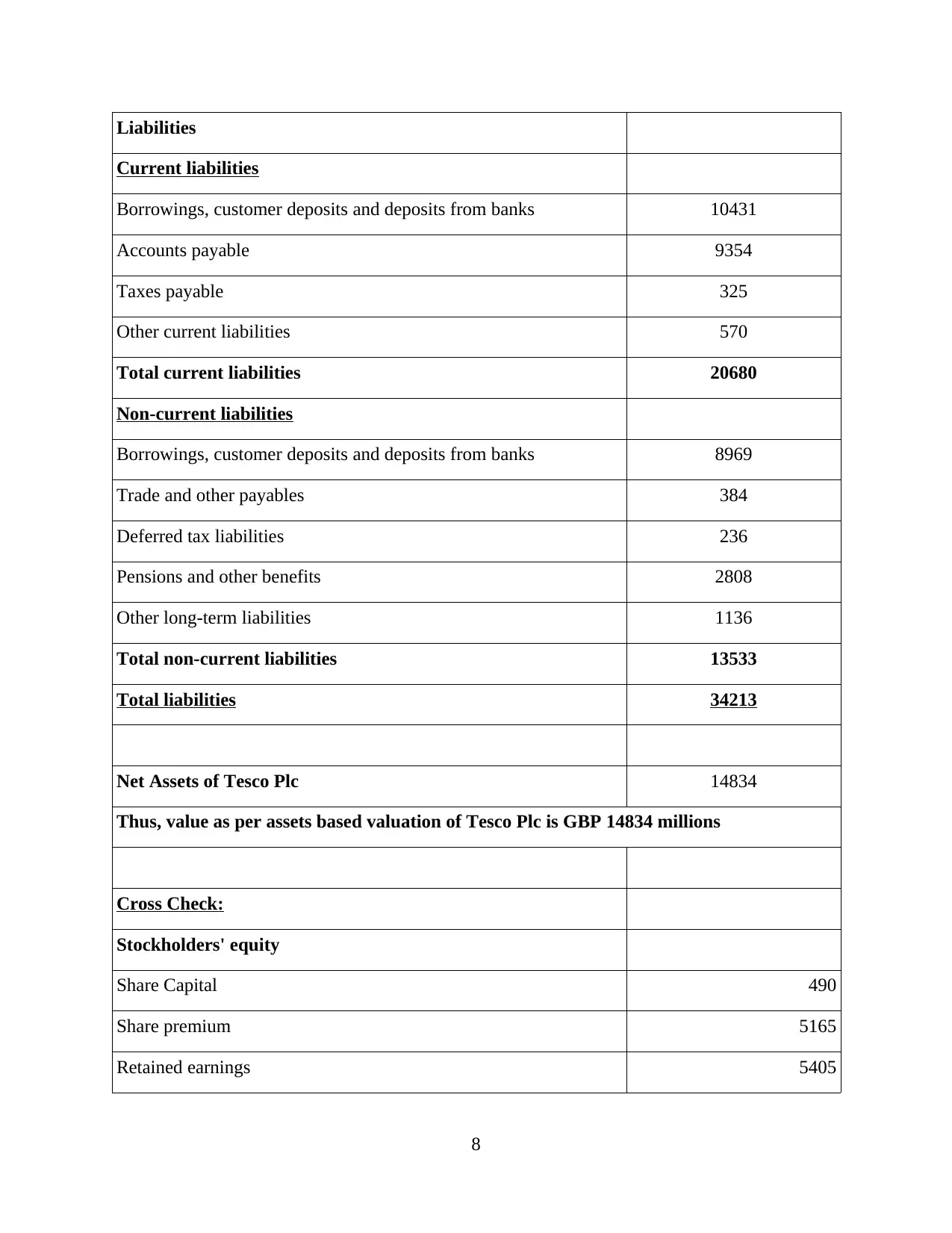
Liabilities
Current liabilities
Borrowings, customer deposits and deposits from banks 10431
Accounts payable 9354
Taxes payable 325
Other current liabilities 570
Total current liabilities 20680
Non-current liabilities
Borrowings, customer deposits and deposits from banks 8969
Trade and other payables 384
Deferred tax liabilities 236
Pensions and other benefits 2808
Other long-term liabilities 1136
Total non-current liabilities 13533
Total liabilities 34213
Net Assets of Tesco Plc 14834
Thus, value as per assets based valuation of Tesco Plc is GBP 14834 millions
Cross Check:
Stockholders' equity
Share Capital 490
Share premium 5165
Retained earnings 5405
8
Current liabilities
Borrowings, customer deposits and deposits from banks 10431
Accounts payable 9354
Taxes payable 325
Other current liabilities 570
Total current liabilities 20680
Non-current liabilities
Borrowings, customer deposits and deposits from banks 8969
Trade and other payables 384
Deferred tax liabilities 236
Pensions and other benefits 2808
Other long-term liabilities 1136
Total non-current liabilities 13533
Total liabilities 34213
Net Assets of Tesco Plc 14834
Thus, value as per assets based valuation of Tesco Plc is GBP 14834 millions
Cross Check:
Stockholders' equity
Share Capital 490
Share premium 5165
Retained earnings 5405
8
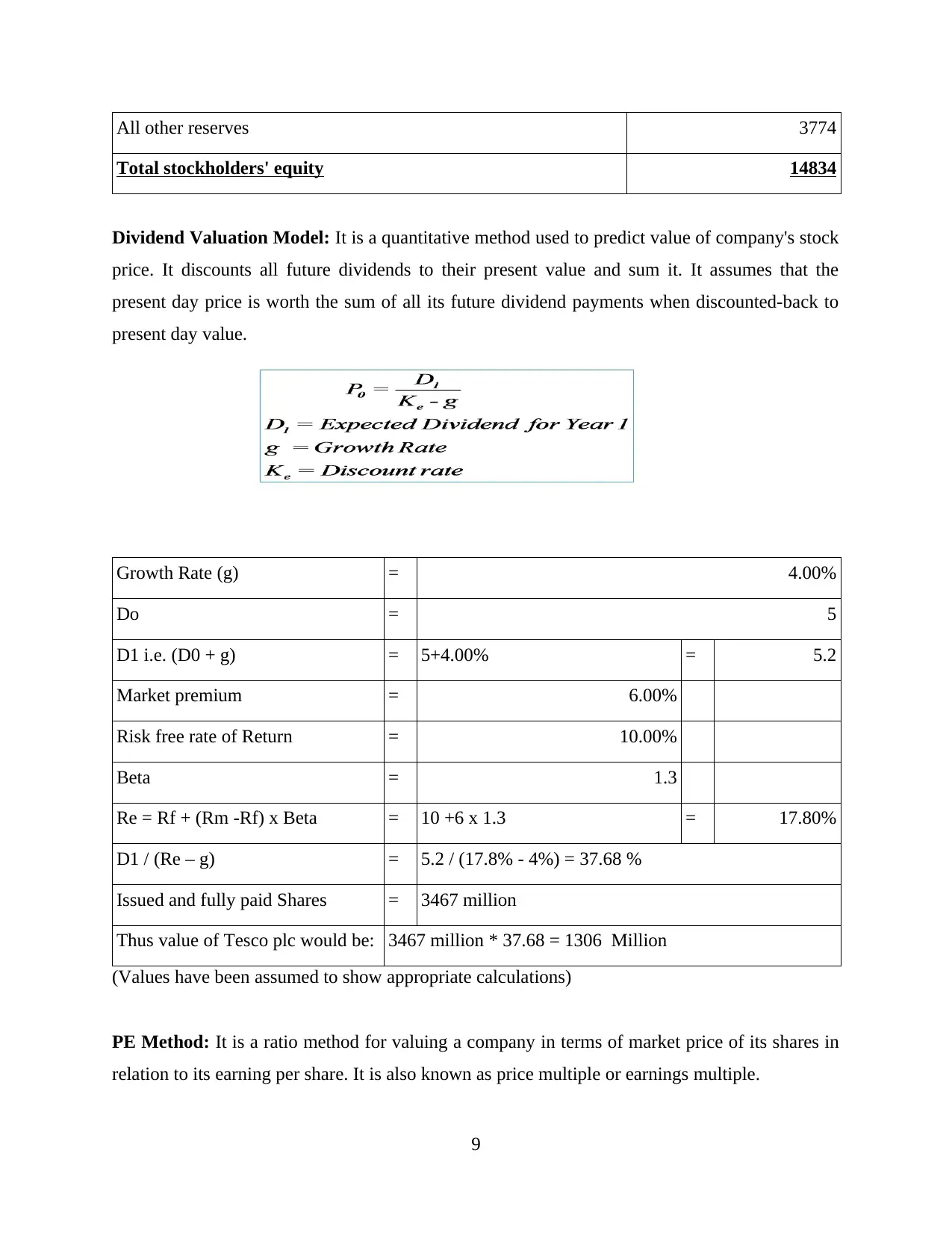
All other reserves 3774
Total stockholders' equity 14834
Dividend Valuation Model: It is a quantitative method used to predict value of company's stock
price. It discounts all future dividends to their present value and sum it. It assumes that the
present day price is worth the sum of all its future dividend payments when discounted-back to
present day value.
Growth Rate (g) = 4.00%
Do = 5
D1 i.e. (D0 + g) = 5+4.00% = 5.2
Market premium = 6.00%
Risk free rate of Return = 10.00%
Beta = 1.3
Re = Rf + (Rm -Rf) x Beta = 10 +6 x 1.3 = 17.80%
D1 / (Re – g) = 5.2 / (17.8% - 4%) = 37.68 %
Issued and fully paid Shares = 3467 million
Thus value of Tesco plc would be: 3467 million * 37.68 = 1306 Million
(Values have been assumed to show appropriate calculations)
PE Method: It is a ratio method for valuing a company in terms of market price of its shares in
relation to its earning per share. It is also known as price multiple or earnings multiple.
9
Total stockholders' equity 14834
Dividend Valuation Model: It is a quantitative method used to predict value of company's stock
price. It discounts all future dividends to their present value and sum it. It assumes that the
present day price is worth the sum of all its future dividend payments when discounted-back to
present day value.
Growth Rate (g) = 4.00%
Do = 5
D1 i.e. (D0 + g) = 5+4.00% = 5.2
Market premium = 6.00%
Risk free rate of Return = 10.00%
Beta = 1.3
Re = Rf + (Rm -Rf) x Beta = 10 +6 x 1.3 = 17.80%
D1 / (Re – g) = 5.2 / (17.8% - 4%) = 37.68 %
Issued and fully paid Shares = 3467 million
Thus value of Tesco plc would be: 3467 million * 37.68 = 1306 Million
(Values have been assumed to show appropriate calculations)
PE Method: It is a ratio method for valuing a company in terms of market price of its shares in
relation to its earning per share. It is also known as price multiple or earnings multiple.
9
⊘ This is a preview!⊘
Do you want full access?
Subscribe today to unlock all pages.

Trusted by 1+ million students worldwide
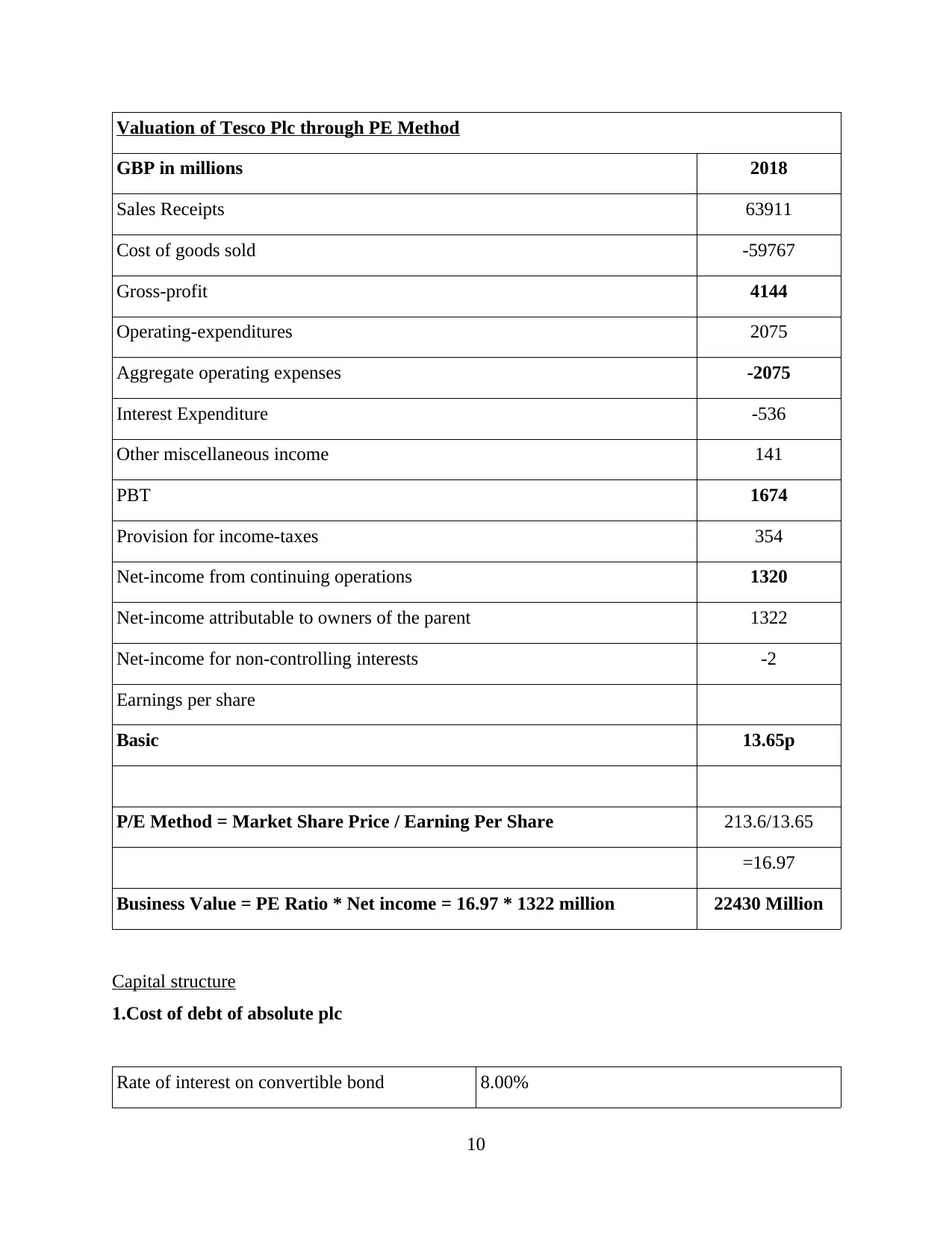
Valuation of Tesco Plc through PE Method
GBP in millions 2018
Sales Receipts 63911
Cost of goods sold -59767
Gross-profit 4144
Operating-expenditures 2075
Aggregate operating expenses -2075
Interest Expenditure -536
Other miscellaneous income 141
PBT 1674
Provision for income-taxes 354
Net-income from continuing operations 1320
Net-income attributable to owners of the parent 1322
Net-income for non-controlling interests -2
Earnings per share
Basic 13.65p
P/E Method = Market Share Price / Earning Per Share 213.6/13.65
=16.97
Business Value = PE Ratio * Net income = 16.97 * 1322 million 22430 Million
Capital structure
1.Cost of debt of absolute plc
Rate of interest on convertible bond 8.00%
10
GBP in millions 2018
Sales Receipts 63911
Cost of goods sold -59767
Gross-profit 4144
Operating-expenditures 2075
Aggregate operating expenses -2075
Interest Expenditure -536
Other miscellaneous income 141
PBT 1674
Provision for income-taxes 354
Net-income from continuing operations 1320
Net-income attributable to owners of the parent 1322
Net-income for non-controlling interests -2
Earnings per share
Basic 13.65p
P/E Method = Market Share Price / Earning Per Share 213.6/13.65
=16.97
Business Value = PE Ratio * Net income = 16.97 * 1322 million 22430 Million
Capital structure
1.Cost of debt of absolute plc
Rate of interest on convertible bond 8.00%
10
Paraphrase This Document
Need a fresh take? Get an instant paraphrase of this document with our AI Paraphraser

Taxation rate 19.00%
8% convertible bond £ 800000
According to above mentioned data, calculation of cost of debt will be:\
Conversion rate = Interest payable * (1 – taxation rate)
= 8% * (1- 0.19)
= 6.48%
Cost of debt (in pounds) = amount of convertible bond* conversion rate
= 800000 * 6.48%
= £ 51840.
2.Cost of equity of Absolute plc
Dividend actually paid 0.30 per ordinary
share
Dividend rate for next year 0.315 per ordinary
share
Market price per share in year 2019 £ 3.20 for each share
Growth rate 5.00%
Formula for calculating cost of equity = (DPS / MPS) + Growth rate
= (0.30 / 3.20) + 5%
= 9.375 + 5 %
= 9.84 %
3. Weighted average cost of capital
Cost of equity as calculated above (Re) 9.84%
Cost of debt as calculated above (Rd) 6.48%
Market value of equity (E) 960000 (3.20×300000)
Market value of debt (D) 100000000 (125×800000)
Total market value of firm (V) 100960000 (960000 +100000000)
11
8% convertible bond £ 800000
According to above mentioned data, calculation of cost of debt will be:\
Conversion rate = Interest payable * (1 – taxation rate)
= 8% * (1- 0.19)
= 6.48%
Cost of debt (in pounds) = amount of convertible bond* conversion rate
= 800000 * 6.48%
= £ 51840.
2.Cost of equity of Absolute plc
Dividend actually paid 0.30 per ordinary
share
Dividend rate for next year 0.315 per ordinary
share
Market price per share in year 2019 £ 3.20 for each share
Growth rate 5.00%
Formula for calculating cost of equity = (DPS / MPS) + Growth rate
= (0.30 / 3.20) + 5%
= 9.375 + 5 %
= 9.84 %
3. Weighted average cost of capital
Cost of equity as calculated above (Re) 9.84%
Cost of debt as calculated above (Rd) 6.48%
Market value of equity (E) 960000 (3.20×300000)
Market value of debt (D) 100000000 (125×800000)
Total market value of firm (V) 100960000 (960000 +100000000)
11
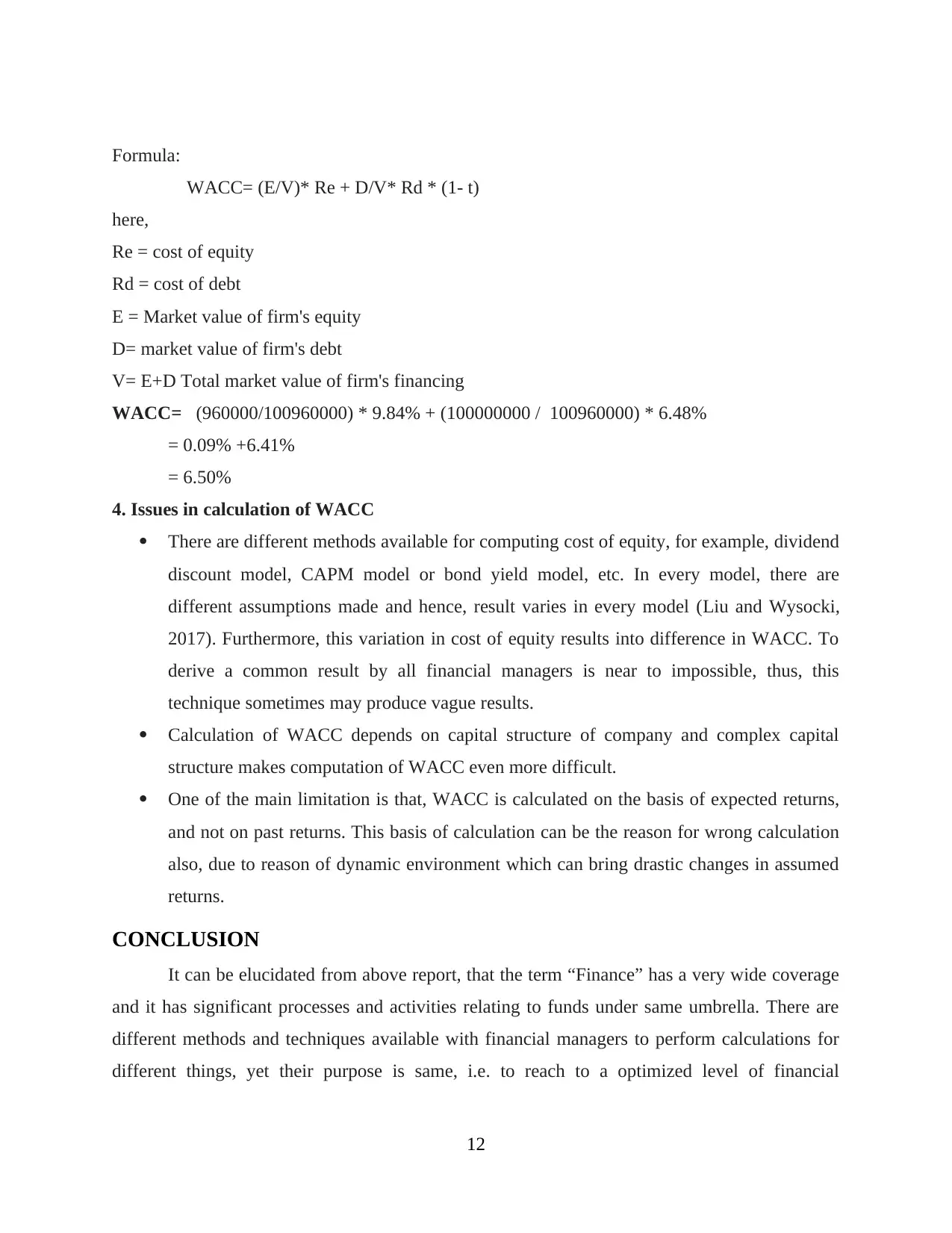
Formula:
WACC= (E/V)* Re + D/V* Rd * (1- t)
here,
Re = cost of equity
Rd = cost of debt
E = Market value of firm's equity
D= market value of firm's debt
V= E+D Total market value of firm's financing
WACC= (960000/100960000) * 9.84% + (100000000 / 100960000) * 6.48%
= 0.09% +6.41%
= 6.50%
4. Issues in calculation of WACC
There are different methods available for computing cost of equity, for example, dividend
discount model, CAPM model or bond yield model, etc. In every model, there are
different assumptions made and hence, result varies in every model (Liu and Wysocki,
2017). Furthermore, this variation in cost of equity results into difference in WACC. To
derive a common result by all financial managers is near to impossible, thus, this
technique sometimes may produce vague results.
Calculation of WACC depends on capital structure of company and complex capital
structure makes computation of WACC even more difficult.
One of the main limitation is that, WACC is calculated on the basis of expected returns,
and not on past returns. This basis of calculation can be the reason for wrong calculation
also, due to reason of dynamic environment which can bring drastic changes in assumed
returns.
CONCLUSION
It can be elucidated from above report, that the term “Finance” has a very wide coverage
and it has significant processes and activities relating to funds under same umbrella. There are
different methods and techniques available with financial managers to perform calculations for
different things, yet their purpose is same, i.e. to reach to a optimized level of financial
12
WACC= (E/V)* Re + D/V* Rd * (1- t)
here,
Re = cost of equity
Rd = cost of debt
E = Market value of firm's equity
D= market value of firm's debt
V= E+D Total market value of firm's financing
WACC= (960000/100960000) * 9.84% + (100000000 / 100960000) * 6.48%
= 0.09% +6.41%
= 6.50%
4. Issues in calculation of WACC
There are different methods available for computing cost of equity, for example, dividend
discount model, CAPM model or bond yield model, etc. In every model, there are
different assumptions made and hence, result varies in every model (Liu and Wysocki,
2017). Furthermore, this variation in cost of equity results into difference in WACC. To
derive a common result by all financial managers is near to impossible, thus, this
technique sometimes may produce vague results.
Calculation of WACC depends on capital structure of company and complex capital
structure makes computation of WACC even more difficult.
One of the main limitation is that, WACC is calculated on the basis of expected returns,
and not on past returns. This basis of calculation can be the reason for wrong calculation
also, due to reason of dynamic environment which can bring drastic changes in assumed
returns.
CONCLUSION
It can be elucidated from above report, that the term “Finance” has a very wide coverage
and it has significant processes and activities relating to funds under same umbrella. There are
different methods and techniques available with financial managers to perform calculations for
different things, yet their purpose is same, i.e. to reach to a optimized level of financial
12
⊘ This is a preview!⊘
Do you want full access?
Subscribe today to unlock all pages.

Trusted by 1+ million students worldwide
1 out of 14
Related Documents
Your All-in-One AI-Powered Toolkit for Academic Success.
+13062052269
info@desklib.com
Available 24*7 on WhatsApp / Email
![[object Object]](/_next/static/media/star-bottom.7253800d.svg)
Unlock your academic potential
Copyright © 2020–2025 A2Z Services. All Rights Reserved. Developed and managed by ZUCOL.




